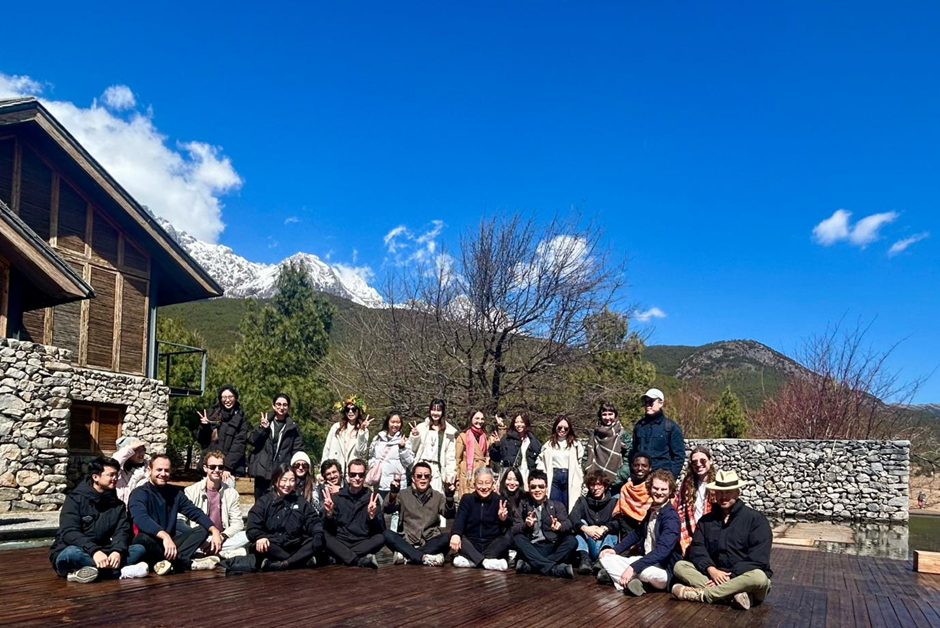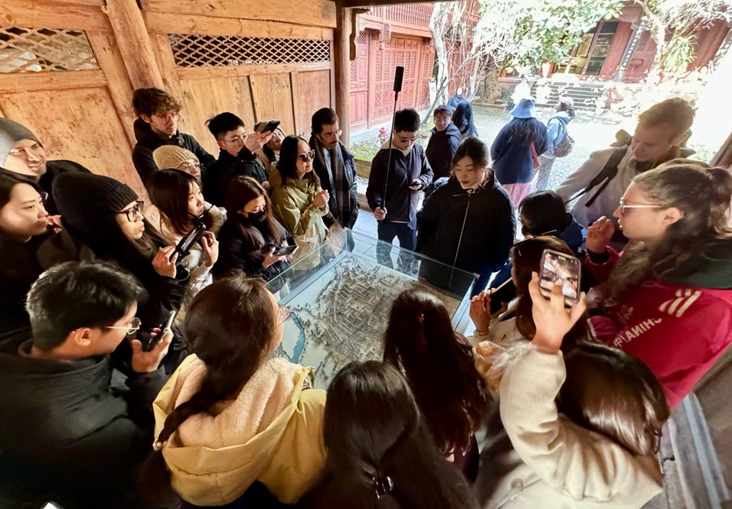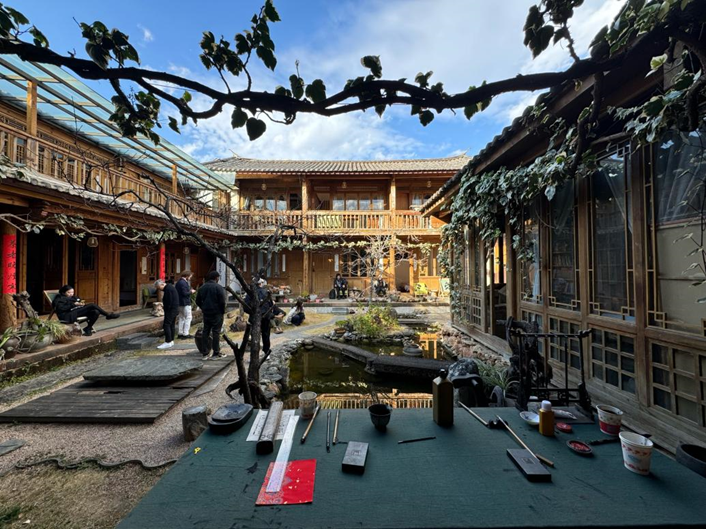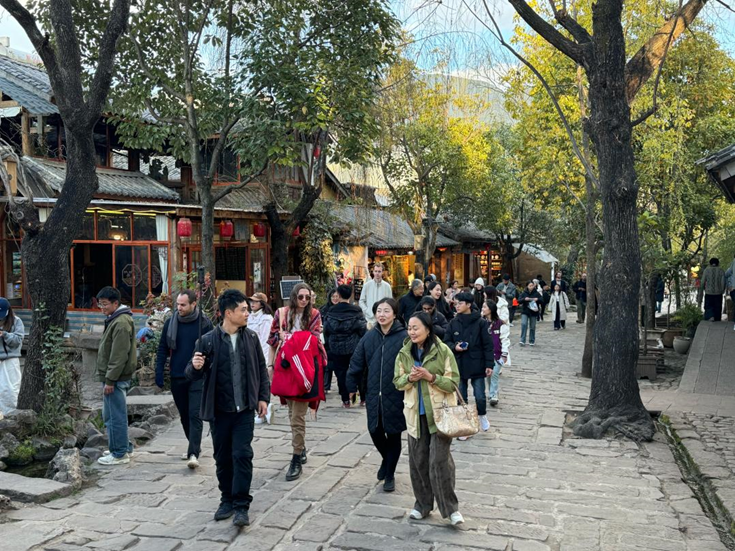
Image: EPMA 2024 Class at Water house by Li Xiaodong Atelier
图片:EPMA 2024级全体学生在李晓东工作室淼庐项目现场
At the start of the Spring semester, the 2024 class of our school’s English Program for Master in Architecture (EPMA) traveled to Yunnan to meet students and faculty from Yunnan University to explore the Ancient Tea Horse Road together. The field trip is part of a joint studio between the two schools that looks at the potential to revitalize communities along the ancient tea-horse road. A total of 22 EPMA students from 18 countries, representing 6 continents where accompanying by several faculty from our school that had prepared an immersive trip.
2024年春季学期伊始,我院建筑学英文硕士项目(EPMA)2024级全体学生在老师们的带领下,赴云南与云南大学师生开展茶马古道联合考察。作为两校联合课程的重要环节,本次实地调研旨在探索茶马古道沿线社区的振兴潜力。来自全球六大洲18个国家的22名EPMA国际学生,在我院多位教师的全程带领下,开启了一场深度文化考察之旅。
Image: Group Photo of Students and Faculty from both schools at Yunnan University School of Architecture
图片:两校师生于云南大学建筑学院合影
About the Joint Studio Topic
联合课程主题
This studio explores the potential of old non-vehicular trail systems to function as present-day templates for both environmental restoration and economic growth. Notwithstanding their status as objects of heritage, we study how these systems might evolve and adapt to changing environmental conditions and how they might leverage low-impact tourism to improve the well-being of communities responsible for the construction and conservation of local landscapes.
此次设计课程聚焦于探索古道系统作为当代环境修复与经济发展中的潜力。尽管这些古道本身是文化遗产,我们重点研究它们如何顺应环境变化而演进和适应,并探讨如何通过可持续旅游开发,提升那些世代守护和塑造当地景观的社区福祉。
In particular, we looked at the the Ancient Tea-Horse Road (茶马古道). This ancient trade network spans across several countries in Asia, totaling some 5,000 kilometers, with rest stops and facilities originally spaced by walking distance of a horse. The path includes high elevation differences, connects various minority cultures through deep valleys and over the tops of mountains. This network facilitated the trading of tea for Tibetan horses and other goods alongside it, shaping regional economies and fostering intercultural connections.
此次,我们聚焦于茶马古道。这条贯穿亚洲多国、绵延约5000公里的古老商贸网络,其沿线驿站最初依马帮单日行程间距而设。整条线路海拔落差显著,穿行于崇山峻岭之间,串联起多个少数民族文化。这一贸易网络以茶马互市为主要形式,兼营其他商品往来,不仅塑造了区域经济发展,更成为不同文明交流互鉴的重要纽带。
Image: Ancient Tea Horse Road
图片:茶马古道
Within this large system, our studio is focused on a segment in China’s Yunnan Province, home base of Yunnan University, out of which we selected two areas of further analysis that represent two modes of the network’s operation: trade and production. This chosen area includes several centers of tea production (like the six ancient tea mountains Xishuangbanna and Pu’er) and important tea trading hubs like Lijiang and Shaxi. Within our EPMA program, the joint studio consists of two parts, with the first 8 weeks focusing on rural planning, and the last 8 weeks focused on designing sustainable architecture interventions. A joint exhibition is planned to share the results of the studio at the end of the semester, and we invite you all to come have a look by then.
在这个庞大的系统中,此次设计课程聚焦于中国云南省境内的一段古道——这里也是云南大学所在地。我们从中选取了两个具有代表性的区域进行深入分析,分别体现了该网络的两种运作模式:贸易与生产。研究区域包含多个茶叶生产中心(如西双版纳的"六大古茶山"和普洱产区),以及丽江、沙溪等重要茶叶贸易枢纽。在我们的EPMA课程框架下,本次联合课程分为两个阶段:前8周着重乡村规划,后8周专注于可持续建筑干预设计。本学期末将举办联合成果展,诚邀各位届时前来参观交流。
The Site Visit
场地调研
Asides from the research topic itself, this joint studio is also a great opportunity to let our international students be more familiar with the challenges and opportunities of rural development in China’s hinterland. We spend several days to explore sites from ancient trading hubs like Lijang, Shaxi en Xizhou, with award winning architecture projects, to the tea-producing regions in the ancient tea-mountains in Xishuangbanna. Below a brief photo diary with some highlights.
除本次研究主题外,本次联合课程也为国际学生提供了一次深入了解中国腹地乡村发展机遇与挑战的宝贵机会。我们历时数日实地考察——从丽江、沙溪、喜洲等荣获建筑奖项的古商贸重镇,到西双版纳古茶山产茶区。以下精选照片记录部分考察亮点。
Day 1: Lijiang old town, Exploring Dongba Culture
第一天:丽江古城,探索东巴文化
Image: Exploring Lijiang Old Town and Local Dongba Minority Cultural at HeiShuiTian Lake
图片:探访丽江古城与黑水潭纳西东巴文化
Day 2 : Shuhe / Yuhu
第二天:束河古镇/玉湖村
Image: Visiting recently completed new homestay project by li xiaodong atelier (right image by UK Studio)
图片:探访李晓东工作室新近完成的民宿项目(右图由UKStudio拍摄)
Day 3 : Shaxi
第三天:沙溪
Image: Visiting traditional horse caravan family homestay cultural heritage site
图片:探访传统马帮家族民宿文化遗产地

Image: Discussing shaxi site model made by scholars of eth Zurich
图片:研讨沙溪村落模型,由苏黎世联邦理工学院学者制作

Image: staying at traditional homestay in Shaxi old town
图片:入住沙溪古镇当地传统民宿

Image: Walking the Ancient tea-horse road through Shaxi
图片:穿行沙溪段茶马古道
Day 4 : Xizhou
第四天:喜洲古镇
Image: visiting linden center in Xizhou
图片:探访喜洲古镇喜林苑
Image: Tsinghua EPMA x Yunnan university students share and exchange during dinner
图片:清华大学EPMA与云南大学学生共进晚餐并进行交流
Day 4 : Shuanglang old town / Erhai Lake
第四天:双廊古镇/洱海
Image: the group was invited to attend a local minority culture celebration for the start of constructing a new home in the community
图片:团队应邀参与当地少数民族社区新房建造启动仪式
Image: EPMA 2024 Class at erhai lake, Dali
图片:EPMA2024级全体学生与老师在大理洱海
Day 5 : Yiwu Ancient Tea Mountain
第五天:易武古茶山
Image: walking along the ancient tea horse road at Yiwu mountain
图片:穿行易武山茶马古道
Image: EPMA 2024 Class at the official start of the ancient tea horse road
图片:EPMA2024级全体学生与老师在茶马古道起点
Day 6 : Academic seminar on ‘breathing new life into the ancient tea horse road’ at Yunnan University
第六天:云南大学“茶马古道焕新生”学术研讨会
Image: Seminar poster and scholars from Yunnan university sharing their research
图片:研讨会海报以及云南大学学者研究成果分享
Image: Tsinghua scholars prof George Kunihiro and assoc prof Martijn de geus sharing at the seminar
图片:清华大学学者国广乔治George Kunihiro教授,以及和马町Martijn de Geus副教授在研讨会上进行学术分享
Image: design studio Review of site visiting analysis, physical models and observations back in the school in Beijing
图片:清华大学建筑设计课程评图(含实地调研分析、实体模型与调研成果)
About our EPMA Program
EPMA英文硕士项目
The English Program for Master in Architecture is a graduate program in the school of architecture of Tsinghua university. Founded in 2008 it was China’s first accredited English graduate program for architecture. Since its founding the program has hosted hundreds of students, from over 60 countries, from all six continents. It has consistently ranked as the best graduate program in architecture in Asia. Amongst amongst peers like MIT, Harvard, UCL Bartlett, TU Delft and ETH Zürich it has recently ranked between top 5 (2021) and top 8 (2024) globally, according to the BAM index for Best Architecture Master programs.
清华大学建筑学院建筑学英文硕士项目(EPMA)是建筑学院开设的研究生学位课程,创立于2008年。作为中国首个获得认证的建筑学英语硕士项目,该项目已累计培养来自全球六大洲60余国家的数百名学子,长期位居亚洲建筑硕士项目第一。在BAM全球建筑硕士排名中,该项目近年全球排名稳居于第5位(2021年)至第8位(2024年)之间,与麻省理工、哈佛大学、伦敦大学学院巴特莱特建筑学院、代尔夫特理工大学及苏黎世联邦理工等顶尖院校共列世界顶尖建筑教育梯队。
CREDITS
致谢
TEACHING TEAM
教学团队
Yunnan University
Prof. Tan Zongbo, Assoc. Prof. Wang Xiaoyun, Lecturer Yang Yaoning
云南大学
谭纵波教授,王晓云副教授,杨耀宁讲师
Tsinghua University
Visiting Prof. George Kunihiro, Assoc. Prof. Martijn de Geus, Assoc. Prof. Lai Yuan, Design Studio Teacher Han Zhang, Teaching Assistant Shen Yi.
清华大学
国广乔治客座教授,和马町副教授,来源副教授,张涵设计课导师,沈逸助教
STUDENTS
学生团队
Yunnan University: 高君怡 Joanna Yolanda ,武斌斌 Wu Binbin ,李相蕴 Li Xiangyun,田雨沛 Tian Yupei,郑礼熙 Zheng Lixi,程潇 Cheng Xiao ,程跃录 Chen yuelu ,杨慧蓉 Yang Huirong ,刘正欢 Liu Zhenghuan,王皓宸 Wang Haochen
Tsinghua :Cristian Fernandez Yepez 欧阳磊,Lucrezia Martinelli 马珍露,Oo Zhi Ling 余芷铃,Teoh Jing Rou 张靖柔,Lim Xiao Ting 林晓婷,Wong Wei Li 王维莉,Bashir Bello 巴希尔,Nong Ting Ting 农婷婷,Hu Yue Luna 胡玥,Lim Chen Hee 林亲喜,Adeliia Shaisultanova 戴丽,Andrew Wilson 威尔柱,Cheng Xin Tung 钟芯童,Arouba Malik 万茹蓓,Deniz Cevik 大海,Lee Si Won 李侍原,Wasin Hemachartwiroon 吴森,Mehdi Nejati Karimabad 麦迪,Bruno Krehula 布鲁诺,Toon Hartman 吴安然,Oren Ben Nahum 白浩然




